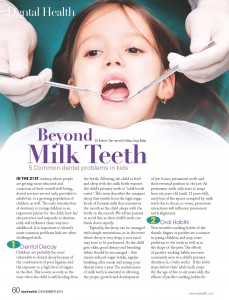 This article first appeared in the November 2013 issue of Ezyhealth magazine. We have reproduced it for the information of those of you who missed it when it was published.
This article first appeared in the November 2013 issue of Ezyhealth magazine. We have reproduced it for the information of those of you who missed it when it was published.
In the 21st century, where people are getting more educated and conscious of their overall well-being, dental services are not only provided to adults but to a growing population of children as well.
The early introduction of dentistry to young children is an important primer for the child; how he/she perceives and responds to dentists early will influence them way into adulthood.
It is important to identify some common problems kids are often challenged with:
DENTAL DECAY
Children are probably the most vulnerable to dental decay because of the combination of poor hygiene and the exposure to a high level of sugars in the diet.
This is seen as early as the time when the child is still feeding from the bottle. Allowing the child to feed and sleep with the milk bottle exposes the child’s primary teeth to “milk bottle caries”. This term describes the rampant decay that results from the high sugar levels of formula milk that remains in the mouth as the child sleeps with the bottle in the mouth. We advise parents to avoid this as their child’s teeth can breakdown rapidly.
Typically, the decay can be managed with simple restorations, or in the event where decay is very deep, a root canal may have to be performed.
As the child gets older, good dietary and brushing habits should be encouraged – this means reduced sugar intake, regular brushing after meals and seeing your dentist twice a year. The maintenance of milk teeth is essential in allowing the proper growth and development of jaw bones, permanent teeth and their eventual position in the jaw.
As permanent teeth only start to erupt from 6 years old (till 12 years old), early loss of the spaces occupied by milk teeth due to decay, or worse, premature extractions will influence permanent teeth alignment.
ORAL HABITS
Non-nutritive sucking habits of the thumb, fingers or pacifier are common in young children, and may cause problems to the teeth as well as to the shape of the jaws.
The effects of pacifier-sucking habits are more commonly seen in a child’s primary dentition (ie. baby teeth). If the habit stops before their adult teeth erupt (by the age of five to six years old), the effects of pacifier-sucking habits do not usually have any long-term impact. However, if the thumb sucking persists till the child is older, these habits may have more effect on the adult teeth.
The extents of the effects of thumb sucking are dependent on the intensity and duration of the habit. The common features of a ‘thumbsucking malocclusion’ include the lack of contact between the front teeth (ie. an anterior open bite).
The types of treatment available to help a child stop his or her thumb sucking habit range from non-physical methods (e.g. motivating the child and explaining the problem) to physical methods (e.g. plasters; bitter nail polishes; deterrent appliances).
DEVELOPMENT OF MALOCCLUSION
A malocclusion (abnormality in the coming together of teeth) occurs when the teeth are misaligned or when the teeth of the upper and lower jaws are in an incorrect relationship. Identifying if a child has a developing malocclusion is important as some treatments, known as ‘Interceptive Orthodontics’, can be carried out early.
Regular dental check-ups from a young age will allow for any potential problems to be identified. The American Association of Orthodontists recommends that all child patients should have an orthodontic assessment no later than the age of seven.
Having crooked teeth may not be the only problem that a child has that requires orthodontic (braces) treatment. Other problems include the presence of extra teeth, the absence of permanent teeth, problems with the bite, and problems with the developing jaws etc. An orthodontic assessment will allow for any early possible treatment to be carried out, or for timely reviews of the child as the permanent teeth erupt.
Routine orthodontic treatment is usually carried out once most of the permanent teeth have erupted into the mouth.
DENTAL PHOBIA
One of the main deterrents of seeing the dentist is fear of the unknown. This is especially pronounced when the child is faced with a stranger in a strange environment ie. the dental office. It is an overwhelming experience and even more so if the child already has a dental problem and is in pain.
The adage “Prevention is better than cure” cannot be truer; it is better to introduce the child as young as two to three years of age to the routine of seeing the dentist. This involves bringing the child along when parents are receiving routine dental treatment (simple cleanings, etc), and having the child become familiar with the dentist as well as the various equipment in the clinic e.g the dental chair, the light and the hand pieces used. By taking these small steps to dispel apprehension and unfounded fear, the child’s acceptance will improve.
In extreme situations where the child may already have problems and is resistant to treatment, where the luxury of time for coaxing is no longer available, then sedation may be required to address the acute issues before reintroducing the child to dentistry in a less stressful moment.
PREMATURE LOSS OF TEETH
Early loss of teeth due to decay or trauma can cause adjacent teeth to drift into the available space. If necessary, space maintainers or retainers can be constructed to allow for adult teeth to erupt into the space if a primary tooth is lost early.
Instill Early a commitment to Oral Health
Maintaining our teeth is a lifelong commitment which we should instill to our children early in life. When we equip our children with the proper life skills and educate them on making the right dietary and health choices, we can be certain they will enjoy eating, smiling and maintain good health throughout their lives.
Dr. Edwin Tan is a Dental Specialist in Prosthodontics with Specialist Dental Group®. He is also a Senior Adjunct Lecturer with the Department of Restorative Dentistry at the National University of Singapore. Dr Tan has a special interest in dental implants, crowns and aesthetic dentistry.
Dr. May Ling Eide is a UK orthodontist with Specialist Dental Group®. She received her specialist training in orthodontics from the University of London, United Kingdom and is registered as an Orthodontist on the Specialist List of the General Dental Council in the United Kingdom. Dr Eide is an Adjunct Clinical Lecturer at the National University of Singapore.







